Collaborative planning of new user experiences for Cityscope
Reaching consensus on the ideal user experience can be challenging. It’s even harder when the product doesn’t exist yet. I’ve been helping the Cityscope development team focus their attentions to deliver something that’s both useful and easy to use.
I’ve recently been involved in an exciting new project to develop a tool that exposes Edinburgh research data to staff, students and local communities.
Cityscope promises to offer new teaching and learning opportunities, and to open up data about the City of Edinburgh (ultimately) to pretty much anyone who’s interested.
Using UX techniques to foster consensus and focus
At the point I was asked to get involved, things were pretty open. The team had solid foundations. They had established what could be done, and the tools and platforms they were going to employ to do it. But there was quite a bit of discussion among the project’s steering group about what they were to do next, why and for whom.
One thing was clear though. For the project to ultimately be a success, this needs to be a tool and a service that is comprehensible to non-tech, non-data people, and something that is as easy as possible to use.
Working with project manager Morna FIndlay I proposed a series of workshops that would enable the team and its steering group to reach consensus about the features that should be prioritized, who they were primarily serving and why.
In our workshops we:
- Developed rough personas, then looked for trends in our perceived user group ideas, rationalised and prioritised them, so we ended up with 4 user archetypes we could attempt to serve.
- Identified measurable business objectives that would indicate we were on the right path, tied them to what we thought the users wanted to do, and from this agreed features we needed to prioritise.
- Planned out a priority user experience; identifying functional requirements, risks and opportunities, and then subsequently ideas for user interfaces.
The workshops
We got together on three occasions, each time for three or so hours.
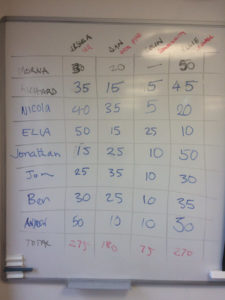
The refined personas were scored by every member of the workshop to collaboratively identify the audiences most important to the project’s success.
Rough persona development
In our first session, around 10 stakeholders joined us to explore who we thought our target users were, what they wanted to do with Cityscope and why.
The group was a mix of academic staff, digital engagement specialists, developers and the project manager. Through a series of collaborative exercises, we narrowed down the target audiences and developed proto-personas that facilitated discussion about the kinds of people who were critically important at to the project’s success, their relationships and how they might be engaged.
The group generated around 20 very rough personas and introduced them to the workshop. Through this process we identified trends and were able to identify the common ground. From this, I was able to harmonise these ideas into 4 personas after the session (with much support from Lauren), ready for review when we next got together.
About a week later we reconvened, with broadly the same set of workshop attendees.
Our first job was to review and ratify the persona development work I’d done outside of the session to ensure that I’d not misrepresented anything fundamental from the first workshop.
The most important thing to bear in mind here is that these personas were not based on any research, but were developed to foster a shared vision amongst the group. One of the most important tasks to undertake in the coming months is to validate our assumptions about the user groups through ongoing engagement and user research activities. The personas will evolve.
Finally, the group assigned a priority score to the personas which quickly revealed that two were considered far more important than the others.
Through this process we were able to confirm that certain fringe audiences were not critical to the project’s success and indeed even amongst those user groups considered important, for the purposes of the initial launch and subsequent months, undergraduates, low-tech users and engaged lecturers are most important.
Prioritising potential features
Building on the insight gleaned through the persona development process, I used most of the second workshop to take the group through the lean UX hypothesis development process.
In this session we listed and prioritised measurable business outcomes we might use to demonstrate that the project was on track, we identified goals our personas might have in the context of using the Cityscope product, and we brainstormed features that could contribute to achieving both of these.
Through a mass of post-it notes, we generated eight hypothesis statements that the team could then focus on validating in the process of their upcoming development work.
Read my earlier posts about Lean UX
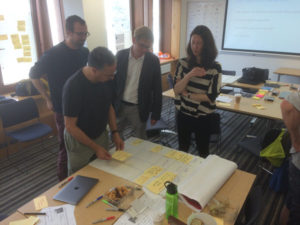
Cityscope stakeholders collaborate to identify potential features that will support the project’s goal.
And here’s an example of the Lean UX hypotheses we developed:
[Our measurable objective] We believe the number of students who have logged into Cityscope will increase
[Our priority persona] if Ursula
[Our persona’s goal] is able to get into Cityscope and try tools out
[Proposed feature] through labelled coursework projects that are searchable.
Scientists like me are generally wary of a process such as persona creation that involves “making things up”. We like hard data. However, the process Neil took us through in our two workshops brought out the preconceptions and assumptions we already had about users of our software. These ideas were implicit and the personas now make them explicit.
Jonathan Silvertown
Cityscope Project Sponsor
Professor of Evolutionary Ecology and Chair in Technology-Enhanced Science Education
Planning the user experience
The final time we got together for a workshop, we reduced the group to the development team as it was felt that the level of detail we were about to get into was not appropriate for the Project’s steering group.
Before we could get into this activity though, we welcomed new development team members who were coming on board due to others leaving the University. It was a great opportunity to introduce the personas and begin to demonstrate their value.
I was particularly happy to be able to step back in these familiarisation exercises and let Morna the Project Manager and Richard the Lead Developer explain who the most important users were and why. Their clarity and consensus when doing this informally was to me a great indicator of the effectiveness of the work we’d done so far.
We then picked on one of our hypotheses from the previous session that was felt to be particularly important, and ran through a series of brainstorming and prioritising activities to begin to shape an experience map that highlighted important service design requirements.
As a final step, we then took a key touch point in the map we’d just developed and began to explore what the Cityscope user interface might look like through a collaborative sketching activity.
Collaborative sketching – previous blog posts on this topic
Conclusion
This is by no means the end of the road for user experience research and design work on the Cityscope project. At this stage though, we’ve achieved the initial goals Morna and I set out earlier in the summer:
- The project has a clear view about who the product and service needs to be prioritising if it to have the best chance of success
- The team has a list of features to investigate building first, with a clear view of why they are doing it and how they might tell whether it’s the right thing to do
- A critical user experience has been mapped out so that it can be checked with target users before too much work is put into development
Most importantly though, the team has the experience and core skills to continue bring user-focus to their work even if they are unable to involve me in the coming months’ work. They can map out further critical experiences, and they can collaboratively develop interfaces to try out with real staff and students.
This has been a very rewarding and enjoyable process for me, and I hope to be able to provide further updates on our collaboration in the coming months as the project begins to build the features that will ultimately deliver an exciting new way for students, staff and the broader Edinburgh community to engage with our university’s world class research outputs.
Get in touch
If any of these workshops or activities sound like they would be useful for your project, or if you’re interested in exploring new ways of getting your team actively collaborating, get in touch.
I can help you start out on your own, or suggest ways in which we can support you.


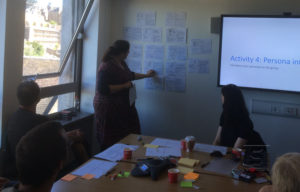
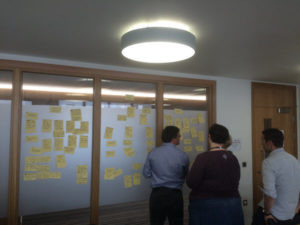
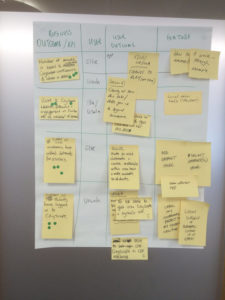
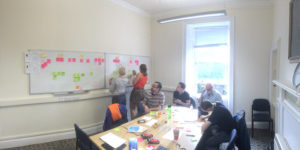
Neil, great to see this write up of the Cityscope workshops. As part of the steering group I found them a useful opportunity to really thrash out some of the details of who our users will be, what their needs are, and how that can relate back to our technical plans, particularly as those plans start to shape the final product.
Thanks again for facilitating these sessions – it will be really exciting to see how the validation of our personas goes over the coming months as Cityscope develops from ideas and prototypes to something much more solid and we get an idea of how that works for our real life users.